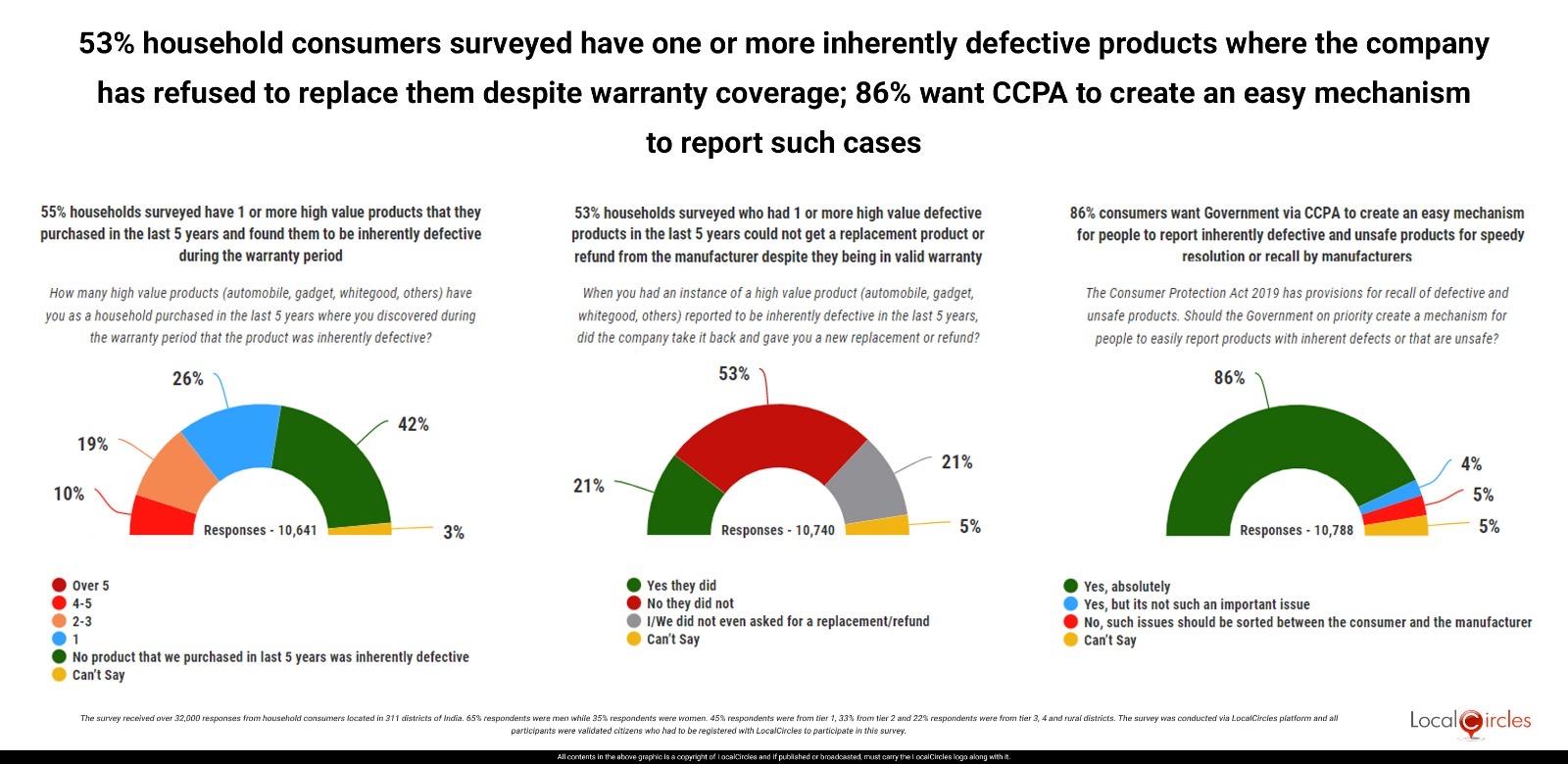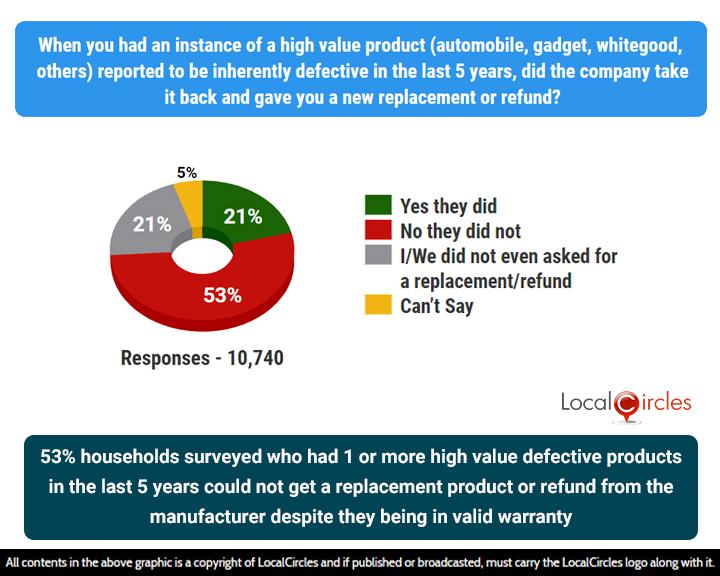53% household consumers surveyed have one or more inherently defective products where the manufacturer has refused to replace/compensate despite being in warranty
- ● 29% household consumers have 3 or more high value inside warranty products that are inherently defective
- ● 86% want CCPA to create an easy mechanism to report such cases; Also want CCPA to create mandatory recall standards/rules for brands for inherently defective products

March 15, 2024, New Delhi: On the World Consumer Rights Day which falls on March 15th, India is focusing on how grievance redressal can be made more consumer centric. One of the top issues that consumers from across the country have regularly shared on LocalCircles is that of non-existent product recall or consumer compensation/replacement in case of inherently defective products.
Under the amended Consumer Protection Act, 2019, all the parties including the manufacturer, suppliers, sellers, etc., are liable for any defective product sold to a consumer. Under this legislation, which came into effect from July 20, 2020, the endorsers or promoters are also liable for promoting a faulty or substandard product.
Product liability (of a manufacturer, service provider or seller) to compensate a consumer for any harm or injury caused by a defective good or deficient service is among the six consumer rights defined in the Bill. To claim compensation, a consumer has to however prove: refusal, after selling goods or rendering services, to take back or withdraw defective goods or to withdraw or discontinue deficient services and to refund the consideration, if paid. All this has to be done within the period stipulated in the bill or cash memo or receipt. And in the absence of such stipulation, within a period of 30 days. The letter requesting return/replacement of a product has to be sent to the seller or manufacturer to either replace the product with a good product or return and refund the amount paid for the product. If this doesn’t work, the aggrieved consumers have the option to go to the consumer court. The consumer can specifically mention in the letter to the seller/ manufacturer the losses/damages incurred by them due to the defects in the product and can specifically ask for payment of damages within a stipulated period. Through this letter, the sender can also ask for the remedies like removing the defects in the product, replacing the product with a new product, refunding the amount paid for the product, and paying the expenses/losses incurred by the sender due to defects in the product.
While all of this sounds good in theory, the practical reality on the ground is very different. According to experiences shared by consumers in the last 24 months on LocalCircles, replacement of a defective product is rarely the case. In one successful case cited by a consumer who received a brand-new laptop with a faulty camera, the consumer had to go through lots of calls and 4 visits by the service technician over a 60 day period to try to repair the camera and only after all efforts failing, the laptop was finally replaced by the manufacturer. This was more of an exception case and according to multiple consumers, brands despite knowing that they have a product defect issue tend to avoid replacing the product and prefer providing repair. The question of contacting other users of the same product simply does not arise and thought process by default is to only assist those consumers who raise the issue. One exception to such practices is automobiles where due to safety considerations at times brands reach out to consumers to get a component/accessory changed at a dealership if an issue is found with the original one. If one studies this issue in detail, they find that the product recall process is not mandated for defective products in India where there is no safety consideration.
Given a large number of complaints that got accumulated on defective product grievance redressal in the last two year, LocalCircles via a new survey has attempted to find out how consumers deal with the issue of inherently defective products, particularly those of high value. The survey received over 32,000 responses from household consumers located in 311 districts of India. 65% respondents were men while 35% respondents were women. 45% respondents were from tier 1, 33% from tier 2 and 22% respondents were from tier 3, 4 and rural districts.
55% of households surveyed that they have at least one high value product which was found to be inherently defective during the warranty period
Despite the law being in place, consumer most often don’t get the resolution they seek without seeking legal help. Responses to the first question brings this to the fore. The question asked respondents, “How many high value products (automobile, gadget, whitegoods, others) have you as a household purchased in the last 5 years where you discovered during the warranty period that the product was inherently defective?” Of the 10,641 respondents 42% stated that they did not have any such product while 3% didn’t give any clear response. However, 55% of households surveyed said that they have at least one high value product which was found to be inherently defective during the warranty period. The data shows that 10% of the respondents have 4-5 such products; 19% have 2-3 such products and 26% have one such product. The fact that 55% of respondents have had an inherently defective product for five years and they have not been able to get a replacement speaks of their helplessness to get the problem resolved.

74% of those surveyed had reached out to the manufacturer/seller/service provider but only 21% got product replacement or refund in the last 5 years
The survey next strived to find out whether the consumers were able to get a product replacement or compensation for the defective product. Surprisingly, 21% out of 10,740 respondents revealed that “I/We did not even ask for a replacement/ refund”, among the remaining 74% reached out to the manufacturer/ seller/ service provider but only 21% got product replacement or refund; and 5% of respondents did not give a clear reply. To sum up, 53% of households surveyed who had one or more high value defective products in the last five years could not get a replacement product or refund from the manufacturer despite the product being inside warranty.

86% want the Government to create a mechanism for people to easily report products with inherent defects or those that are unsafe
The survey next asked consumers “The Consumer Protection Act 2019 has provisions for recall of defective and unsafe products. Should the Government on priority create a mechanism for people to easily report products with inherent defects or those that are unsafe?” Majority of the 10,788 respondents to this query felt this would be the best option. The data shows that 86% want this mode to put spotlight on defective products and for consumer safety and grievance redressal; while 4% want government action while feeling “it’s not such an important issue”; 5% stated that “No, such issues should be sorted between the consumers and the manufacturer” and 5% indicated no clear stance. To sum up, 86% of consumers surveyed want the Government via CCPA to create an easy mechanism for people to report inherently defective and unsafe products for speedy resolution or recall be manufacturers.

Most Indian consumers generally only evaluate the product features or functions, prices, discounts, look and feel before making their purchase decision with limited attention paid to service and support. LocalCircles in a previous survey in 2022 found that the real battle for some consumers begins when they find the high-value product they bought is not functioning properly and has an inherent defect. Those consumers who are aware resort to reaching the warranty department of the brand to find redressal while others get it repaired locally. Many others just end up using these defective products unless it is completely defunct.
In summary, the survey finds that 53% households have one or more products that were found to be inherently defective but the consumers have not been able to get any replacement or compensation from the manufacturer/ seller in the last five years. This could explain why 86% of consumers surveyed want an easy mechanism to report inherently defective products which could be unsafe too, in the expectation that the CCPA would take action against such manufacturers. The need of the hour is for CCPA to lay out a mandatory standard process for product recalls that all brands must follow, especially for products like automobiles, gadgets, whitegoods and any such serviceable products. In addition to that the CCPA must be much more vigilant to consumer complaints such that they can observe potential cases of defective products quickly and must take suo moto action against such products and brands. An inherently defective product is far more damaging for the brand too in the long run as it breaks consumer trust and hence faster identification can drive quick corrective action and consumer retention.
LocalCircles will share the findings of this survey with the relevant stakeholders in Government of India and create public awareness about the same so all stakeholders can work towards addressing this issue. In the long run, faster defect identification means better quality products from India, something that is a must for long term success of “Make in India”.
Survey Demographics
The survey received over 32,000 responses from household consumers located in 311 districts of India. 65% respondents were men while 35% respondents were women. 45% respondents were from tier 1, 33% from tier 2 and 22% respondents were from tier 3, 4 and rural districts. The survey was conducted via the LocalCircles platform and all participants were validated citizens who had to be registered with LocalCircles to participate in this survey.
About LocalCircles
LocalCircles, India’s leading Community Social Media platform enables citizens and small businesses to escalate issues for policy and enforcement interventions and enables Government to make policies that are citizen and small business centric. LocalCircles is also India’s # 1 pollster on issues of governance, public and consumer interest. More about LocalCircles can be found on https://www.localcircles.com
For more queries - media@localcircles.com, +91-8585909866
All content in this report is a copyright of LocalCircles. Any reproduction or redistribution of the graphics or the data therein requires the LocalCircles logo to be carried along with it. In case any violation is observed LocalCircles reserves the right to take legal action.
Enter your email & mobile number and we will send you the instructions.
Note - The email can sometime gets delivered to the spam folder, so the instruction will be send to your mobile as well


